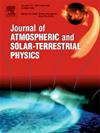Simultaneous evaluation of solar activity proxies during geomagnetic storms using principal component analysis: Case study of the African low and mid-latitude regions
IF 1.8
4区 地球科学
Q3 GEOCHEMISTRY & GEOPHYSICS
Journal of Atmospheric and Solar-Terrestrial Physics
Pub Date : 2025-03-24
DOI:10.1016/j.jastp.2025.106477
引用次数: 0
Abstract
We simultaneously evaluate the contributions of the mostly used solar activity indices to the modelling of geomagnetic storms using principal component analysis (PCA). The selected indices are the sunspot number (SSN), solar radio flux at a wavelength of 10.7 cm (), 12-month running average of SSN (), 81-day running average of (), and the modified index herein referred to as . The assessment of these indices was accomplished by first developing five storm-time empirical models of the ionosphere with ionospheric total electron content (TEC) as dependent variable, and each of the five solar proxies as the independent variable. As the energy from the Sun differs from one latitudinal region to another on Earth, two locations at different latitudes were considered for the analysis. Based on their long data coverage periods, Hartebeesthoek (HRAO, geographic coordinates: 25.89° S, 27.69° E; geomagnetic coordinates: 36.32° S, 94.69° E), South Africa; and Mbarara (MBAR, geographic coordinates: S and E, geomagnetic coordinates: S and E), Uganda, were chosen to represent the middle and low latitude ionospheric regions, respectively. Their data coverage periods are 27 September 1996 to 30 March 2024 (HRAO) and 17 July 2001 to 30 March 2024 (MBAR) and only storm-time TEC data within these periods selected based on the criterion nT or were considered for the statistical analysis. Through PCA decomposition, TEC data were broken up into a matrix of principal directions of the maximum variances in the dataset (or matrix of eigenvectors of the covariance matrix) and a matrix of principal components (PCs) which represent the projection of data onto the principal directions. For each model, PCs were thereafter modelled in terms of the corresponding solar activity index and the modelled quantities were further combined with the original PC vectors to get the reconstructed TEC for the entire period of the study. With reference to the ionospheric storm-time model implemented using SSN as solar activity representation, a statistical analysis revealed that, overall, the storm-time empirical models developed using either , , , or , perform about 8%, 15%, 18%, 22%, respectively, better in reconstructing actual TEC than the SSN based model for HRAO, and 11%, 23%, 19%, 24% for MBAR. Validating the models over selected four storms, results showed that running average based indices led to more accurate TEC predictions compared to the usual daily Wolf’s SSN and .
我们使用主成分分析法(PCA)同时评估了最常用的太阳活动指数对地磁暴建模的贡献。所选指数包括太阳黑子数(SSN)、波长为 10.7 厘米的太阳射电通量(F10.7)、SSN 的 12 个月运行平均值(R12)、F10.7 的 81 天运行平均值(F10.781)以及修正的 F10.7 指数(在此称为 F10.7p)。评估这些指数的方法是,首先建立五个电离层风暴时间经验模型,以电离层电子总含量(TEC)为因变量,以五个太阳代用指标中的每一个为自变量。由于地球上不同纬度地区的太阳能量不同,因此考虑在不同纬度的两个地点进行分析。哈特比斯特霍克(HRAO,地理坐标:南纬 25.89°,北纬 27.00°)的数据覆盖期较长:地理坐标:南纬 25.89°,东经 27.69°;地磁坐标:南纬 36.32°,东经 94°:南纬 36.32°,东经 94.69°)和姆巴拉拉(MBAR,地理坐标:南纬 0.60°,东经 30°):地理坐标:南纬 0.60°,东经 30.74°;地磁坐标:南纬 10.22°,东经 102°:选择乌干达的姆巴拉拉(MBAR,地理坐标:南纬 0.60 度和东经 30.74 度,地磁坐标:南纬 10.22 度和东经 102.36 度)分别代表中纬度和低纬度电离层区域。它们的数据覆盖期分别为 1996 年 9 月 27 日至 2024 年 3 月 30 日(HRAO)和 2001 年 7 月 17 日至 2024 年 3 月 30 日(MBAR),在统计分析中只考虑根据 Dst⩽-50 nT 或 Kp⩾4 标准选定的这些期间内的风暴时间 TEC 数据。通过 PCA 分解,TEC 数据被分解为数据集中最大方差的主方向矩阵(或协方差矩阵的特征向量矩阵)和主成分矩阵(PCs),后者代表数据在主方向上的投影。对于每个模型,随后根据相应的太阳活动指数对主成分进行建模,并将建模量与原始主成分向量进一步结合,以得到整个研究期间的重建 TEC。关于使用 SSN 作为太阳活动表示的电离层风暴时间模型,统计分析表明,总体 而言,使用 F10.7、F10.781、R12 或 F10.7p 开发的风暴时间经验模型在重建实际 TEC 方面的性能分别比基于 SSN 的 HRAO 模型好约 8%、15%、18%和 22%,比基于 MBAR 的模型好约 11%、23%、19%和 24%。结果表明,与通常的沃尔夫每日 SSN 和 F10.7 指数相比,基于运行平均值的指数能更准确地预测 TEC。
本文章由计算机程序翻译,如有差异,请以英文原文为准。
求助全文
约1分钟内获得全文
求助全文
来源期刊

Journal of Atmospheric and Solar-Terrestrial Physics
地学-地球化学与地球物理
CiteScore
4.10
自引率
5.30%
发文量
95
审稿时长
6 months
期刊介绍:
The Journal of Atmospheric and Solar-Terrestrial Physics (JASTP) is an international journal concerned with the inter-disciplinary science of the Earth''s atmospheric and space environment, especially the highly varied and highly variable physical phenomena that occur in this natural laboratory and the processes that couple them.
The journal covers the physical processes operating in the troposphere, stratosphere, mesosphere, thermosphere, ionosphere, magnetosphere, the Sun, interplanetary medium, and heliosphere. Phenomena occurring in other "spheres", solar influences on climate, and supporting laboratory measurements are also considered. The journal deals especially with the coupling between the different regions.
Solar flares, coronal mass ejections, and other energetic events on the Sun create interesting and important perturbations in the near-Earth space environment. The physics of such "space weather" is central to the Journal of Atmospheric and Solar-Terrestrial Physics and the journal welcomes papers that lead in the direction of a predictive understanding of the coupled system. Regarding the upper atmosphere, the subjects of aeronomy, geomagnetism and geoelectricity, auroral phenomena, radio wave propagation, and plasma instabilities, are examples within the broad field of solar-terrestrial physics which emphasise the energy exchange between the solar wind, the magnetospheric and ionospheric plasmas, and the neutral gas. In the lower atmosphere, topics covered range from mesoscale to global scale dynamics, to atmospheric electricity, lightning and its effects, and to anthropogenic changes.
 求助内容:
求助内容: 应助结果提醒方式:
应助结果提醒方式:


